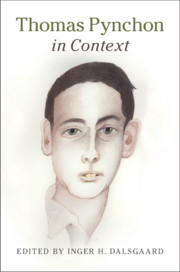Book contents
- Thomas Pynchon in Context
- Thomas Pynchon in Context
- Copyright page
- Contents
- Contributors
- Abbreviations
- Chronology
- Introduction
- Part I Times and Places
- Part II Culture, Politics, and Society
- Chapter 14 Family
- Chapter 15 Sex and Gender
- Chapter 16 Humor
- Chapter 17 Popular Culture
- Chapter 18 Music and Sound
- Chapter 19 Film and Television
- Chapter 20 Real Estate and the Internet
- Chapter 21 Politics and Counterculture
- Chapter 22 Drugs and Hippies
- Chapter 23 Ecology and the Environment
- Chapter 24 Capitalism and Class
- Chapter 25 War and Power
- Chapter 26 Conspiracy and Paranoia
- Chapter 27 Terror and Anarchy
- Chapter 28 Science and Technology
- Chapter 29 Mathematics
- Chapter 30 Time and Relativity
- Chapter 31 Philosophy
- Chapter 32 Religion and Spirituality
- Chapter 33 Death and Afterlife
- Part III Approaches and Readings
- Further Reading
- Index
Chapter 33 - Death and Afterlife
from Part II - Culture, Politics, and Society
Published online by Cambridge University Press: 31 May 2019
- Thomas Pynchon in Context
- Thomas Pynchon in Context
- Copyright page
- Contents
- Contributors
- Abbreviations
- Chronology
- Introduction
- Part I Times and Places
- Part II Culture, Politics, and Society
- Chapter 14 Family
- Chapter 15 Sex and Gender
- Chapter 16 Humor
- Chapter 17 Popular Culture
- Chapter 18 Music and Sound
- Chapter 19 Film and Television
- Chapter 20 Real Estate and the Internet
- Chapter 21 Politics and Counterculture
- Chapter 22 Drugs and Hippies
- Chapter 23 Ecology and the Environment
- Chapter 24 Capitalism and Class
- Chapter 25 War and Power
- Chapter 26 Conspiracy and Paranoia
- Chapter 27 Terror and Anarchy
- Chapter 28 Science and Technology
- Chapter 29 Mathematics
- Chapter 30 Time and Relativity
- Chapter 31 Philosophy
- Chapter 32 Religion and Spirituality
- Chapter 33 Death and Afterlife
- Part III Approaches and Readings
- Further Reading
- Index
Summary
Ontological ambiguity permeates Thomas Pynchon’s characters: Time and again, they hover between existence and nonexistence. Sometimes it is just a passing feeling that the character is not really alive; sometimes characters that were supposed to be dead enter the narrative scene; sometimes characters are so abstract and conceptualized that it makes one wonder whether they exist at all as positive entities – and often all of this may occur within the same novel.
Ontologically unstable characters, the frequency of Spiritualism and other paranormal themes, violence, mass destruction, and apocalyptic imagery – all contribute to Pynchon’s labeling as a death-obsessed writer. Criticism has often portrayed death as a kind of monolithic theme in his work: the sinister dark side that counterpoints the narrative extravaganza of characters, plots, subplots, settings, discourses and styles, topics, historical minutiae, humor, and so on. But death in Pynchon is just as multifaceted as its supposed opposite, life.
- Type
- Chapter
- Information
- Thomas Pynchon in Context , pp. 262 - 270Publisher: Cambridge University PressPrint publication year: 2019



